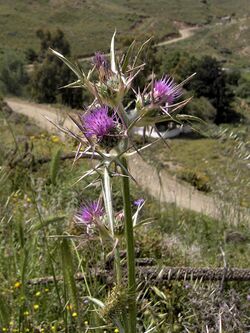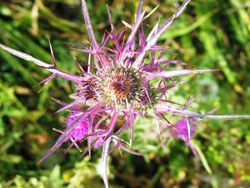Biology:Notobasis syriaca
| Notobasis syriaca | |
|---|---|

| |
| Scientific classification | |
| Kingdom: | Plantae |
| Clade: | Tracheophytes |
| Clade: | Angiosperms |
| Clade: | Eudicots |
| Clade: | Asterids |
| Order: | Asterales |
| Family: | Asteraceae |
| Genus: | Notobasis |
| Species: | N. syriaca
|
| Binomial name | |
| Notobasis syriaca (L.) Cass.
| |
| Synonyms[1] | |
| |
Notobasis syriaca, the Syrian thistle,[2] is a species of flowering plant in the tribe Cardueae within the family Asteraceae. It is native to the Mediterranean region and the Middle East, from Madeira, the Canary Islands, Morocco and Portugal east to Egypt, Iran and Azerbaijan.
It is an annual plant belonging to the semi-desert flora, growing to 30–100 cm tall. The leaves are spirally arranged on the stems, deeply lobed, grey-green with white veins, and sharp spines on the margins and apex. The flowers are purple, produced in a dense flowerhead (capitulum) 2 cm diameter, surrounded by several spiny basal bracts.[3]
In the Greek island of Crete, where it is called agavanos (αγκάβανος), its tender shoots are peeled and eaten raw by the local people.
It is naturalised in Australia .
References
- ↑ Flann, C (ed) 2009+ Global Compositae Checklist
- ↑ (xls) BSBI List 2007, Botanical Society of Britain and Ireland, https://bsbi.org/download/3542/, retrieved 2014-10-17
- ↑ Altervista Flora Italiana, genere Notobasis includes photos and distribution maps
Wikidata ☰ Q148933 entry
 |


